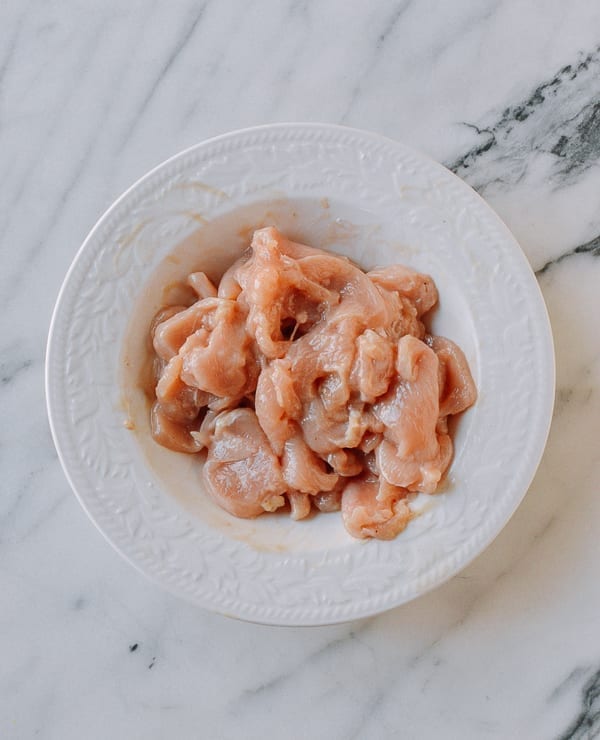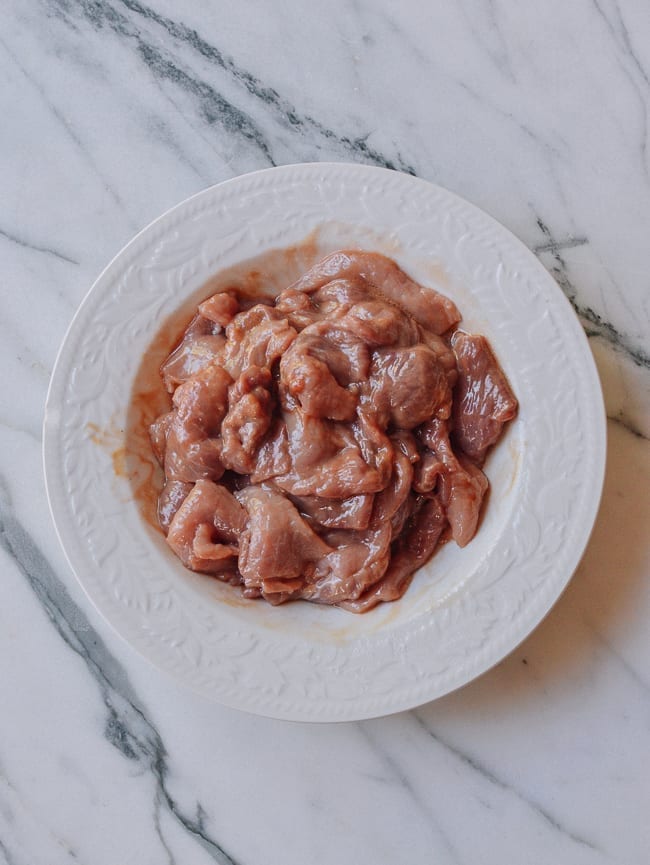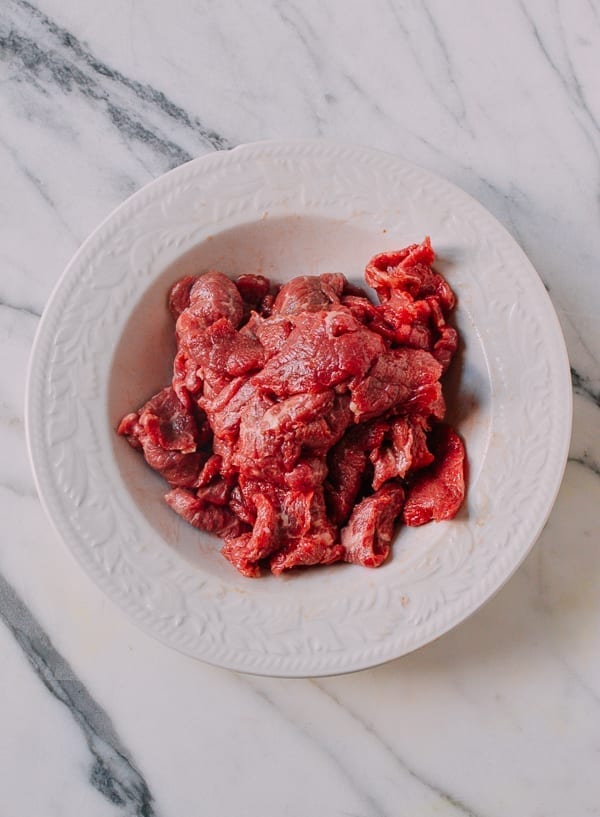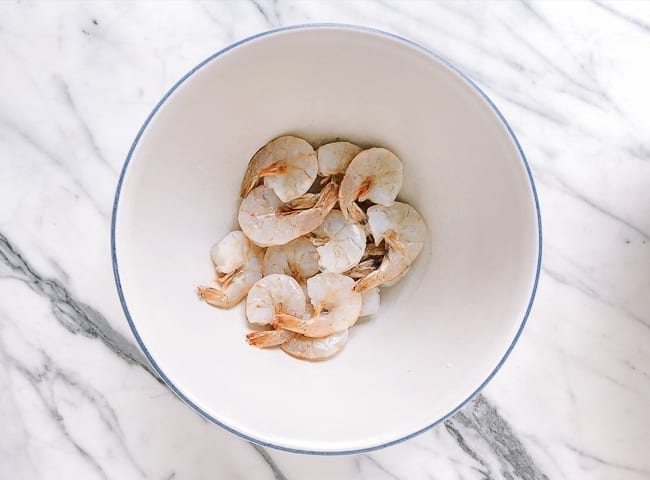This recipe for Thai Basil Noodles doesn’t skimp on the basil! It’s full of flavor, and you can customize it to add your favorite protein, whether it’s chicken, beef, pork, or shrimp.
If you’ve found yourself breaking the bank on takeout, you may be surprised at how quick and easy this dish is to make at home!
Thai Basil As Veg, Not Garnish
Whenever I see Thai basil noodles or Thai basil fried rice on a menu, I’m ordering it. I LOVE Thai basil, and I’m looking for a perhaps unreasonable ratio of basil to noodle/rice.
While we often think of basil as a garnish or final add-in, in Thailand, it is often added in quantities similar to other vegetables in the dish. I think of it almost like adding spinach to a recipe. I don’t just want specks of green here and there, but big pops of it throughout.
In short, this recipe does not skimp on the basil. You add two full cups of it (which is also good, because if you’re buying a packet/bunch of it, you might as well use as much as you can, because it browns and wilts easily in the fridge).
And if you’re growing it in your garden or in a pot on your patio or deck, you know that it’s a vigorous plant that grows rampant in summer, when there’s more than enough sunlight and heat to make it happy.
Harvesting it will make it re-grow more vigorously, so don’t be shy about picking it.
Customize Your Protein
This recipe is a base. It’s delicious on its own, but is also a canvas to which you can add whatever protein you like or have on hand.
You would only need about 8 ounces of whatever protein you’re looking to add here. Here’s how to add it:
- Follow our velveting instructions for chicken, beef, pork, or shrimp to prepare and marinate.
- Heat your wok or pan until it’s just starting to smoke, or until a splash of water beads up and dances around the pan. (If using a non-stick pan, just heat until the pan is nice and hot.) Pre-sear the protein in a tablespoon or two of oil.
- Remove the seared protein to a plate or bowl. Then proceed with the recipe. There’s no need to wash the pan before continuing.
- Add the protein in the final step of the recipe, along with the Thai basil and scallion greens
From chickento porkto beef and shrimpwe have velveting instructions for all! Click on any of the images below for instructions.
In the recipe card, you can click on the number of servings, and then use the slider to adjust the recipe for 8 ounces of protein.




The Sauces
We’re using a Thai thin soy sauce, which is available at many Chinese and Southeast Asian grocery stores. Healthy Boy is the most ubiquitous brand. That said, you can substitute Chinese light soy sauce or any regular soy sauce you have on hand.
For the dark soy sauce, you can use Thai black soy sauce or Chinese dark soy sauce. Both are required to give these noodles that dark amber color.
I also used a mixture of oyster sauce and fish sauce to create a deep umami flavor.
Even if you’re not a seafood lover, do not leave these ingredients out. They are really responsible for creating flavor complexity in the dish!
In fact, in one recipe testing round, I forgot to add the fish sauce, and immediately noted its absence upon tasting the noodles. The dish just didn’t have the same fragrance and deliciousness.
If you have a dietary restriction, see the box below for substitutions.
Recipe adjustments for Dietary restrictions:
Shellfish Allergy?
Replace the oyster sauce with a vegetarian oyster sauce (which is made with mushrooms).
Vegan?
Replace the oyster sauce with a vegetarian oyster sauce and use a vegan fish sauce.
Gluten-free?
Use a gluten-free soy sauce. For the dark soy sauce, you can make our dark soy sauce substitution using that GF soy (by basically mixing in a little molasses and sugar). Lee Kum Kee makes a gluten-free oyster sauce, and Red Boat is a great option for GF fish sauce!
Spice Tolerance?
Here’s how to adjust the recipe according to your spice tolerance:
Mild: Omit the Thai chilies entirely.
Medium: Use 1 Thai chili. If you think you can take it, use 2.
Hot: Use 3 Thai chilies. This is what we did. The noodles were spicy, but addictively so, at least for us chili heads!
Okay, let’s get cooking.
Thai Basil Noodles: Recipe Instructions
Bring a pot of water to a boil for the noodles. We find that package cooking instructions can be inconsistent, so check the noodles often until they’re al dente (cooked through but still firm and chewy). For our noodles, total cook time was about 5 minutes. Drain them in a colander, and rinse in cold water.

Stir together the dissolved brown sugar mixture, Thai thin soy sauce, fish sauce, and oyster sauce in a small bowl. Prepare your other ingredients and have them ready before you start cooking.

Heat your wok until it’s close to smoking, and spread 2 tablespoons of oil around the perimeter of the wok. Add the garlic, white parts of the scallion, Thai chilies, and bell pepper. Stir-fry for 30 seconds.

Add the rice noodles. Use a scooping motion to mix everything for another minute until the noodles warm up.

Next, add the prepared sauce mixture and stir-fry at the highest heat for about 1 minute until the noodles are uniform in color. Take care to use your metal spatula to scrape the bottom of the wok to prevent sticking.

Add the Thai basil and the green parts of the scallions, and stir-fry just until the leaves are wilted.

Serve!


Thai Basil Noodles
This restaurant quality recipe for Thai Basil Noodles is full of flavor! Make it as is, or add chicken, beef, pork, or shrimp.

serves: 4
Prep: 15 minutes
Cook: 15 minutes
Total: 30 minutes
Instructions
-
Bring a pot of water to a boil for the noodles. We find that package cooking instructions can be inconsistent, so check the noodles often until they’re al dente (cooked through but still firm and chewy). For our noodles, total cook time was about 5 minutes. Drain them in a colander, and rinse in cold water.
-
Stir together the dissolved brown sugar mixture, Thai thin soy sauce, fish sauce, and oyster sauce in a small bowl.
-
Heat your wok until it’s close to smoking, and spread 2 tablespoons of oil around the perimeter of the wok. Add the garlic, white parts of the scallion, Thai chilies, and bell pepper. Stir-fry for 30 seconds.
-
Add the rice noodles. Use a scooping motion to mix everything for another minute until the noodles warm up.
-
Next, add the prepared sauce mixture and stir-fry at the highest heat for about 1 minute until the noodles are uniform in color. Take care to use your metal spatula to scrape the bottom of the wok to prevent sticking.
-
Add the Thai basil and the green parts of the scallions, and stir-fry just until the leaves are wilted. Serve!
nutrition facts
Calories: 291kcal (15%) Carbohydrates: 52g (17%) Protein: 4g (8%) Fat: 7g (11%) Saturated Fat: 1g (5%) Polyunsaturated Fat: 2g Monounsaturated Fat: 5g Trans Fat: 0.03g Sodium: 793mg (33%) Potassium: 146mg (4%) Fiber: 2g (8%) Sugar: 2g (2%) Vitamin A: 1198IU (24%) Vitamin C: 25mg (30%) Calcium: 48mg (5%) Iron: 1mg (6%)

